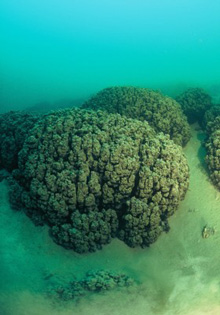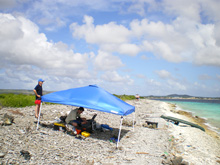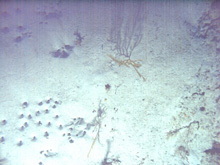Tracking the Steep Reefs of Bonaire
Freshwater microbialites. Click image for larger view and image credit.
Shore operations on Klein Bonaire. Click image for larger view and image credit.
January 27, 2008
Alex Forrest
University of British Columbia
One of the challenges of exploring coral reefs with autonomous underwater vehicles (AUVs) is being able to accurately track the bottom in order to get quality pictures and sonar images. Prior to coming here the team from the University of British Columbia thought that we were well prepared to handle this problem in the ocean as part of our work with UBC-Gavia (a small-sized AUV) in mapping "microbialites" — calcium carbonate mounds that result from the presence of a microbial community —in a steep-sided lake. Typical slope angles at this site vary from around 10º to 15º.
When we started operations here in Bonaire, we immediately noticed that the slope angles where the reef was growing was much steeper than that — about 20º to 30º. This posed an immediate challenge for us as the dive angle of the vehicle is set around 15º. This number allows for the vehicle to bottom-lock (track the ground bottom on descent). Experimental missions were then run to see if this angle could be increased, compromising the vehicle when it needed to return to the surface. This means that it would need to be able to pull out of the descent in a short enough period of time. We found that we were able to push this angle to about a 25º, which gave us somewhat better performance although still not enough to be able to track the bottom the entire way down. In the end, we found that we were able to get better pictures on the return to the surface, as the vehicle would pause periodically if the ground got to close.
During the earlier missions, we had several friendly competitions with the other Icelandic team operating a Gavia vehicle to see who could go deepest and collect images from depth. With the depth rating of the vehicles being between 300 and 500 meters (m)/984 and 1,640 feet (ft), the official record had been set last year by our team at 140 m (459 ft). This was quickly beat by their vehicle at 180 m (590 ft) on the third day. We thought that we stood a good chance of catching up when we changed the dive angles. Although we did get down to 207 m (679 ft), we never managed to beat their final record of 220 m (722 ft) that they set on the final day of operations. Sadly, the deepest image we collected (see photo) was at 147 m (482 ft) as we lost track of the bottom at depths beyond that!
Sign up for the Ocean Explorer E-mail Update List.





























